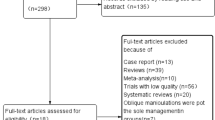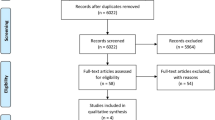Abstract
We used the response surface methodology to investigate the direct and interactive effects of three explanatory variables on three properties of a calcium phosphate cement (CPC) for use in vertebroplasty (VP) and balloon kyphoplasty (BKP). The variables were poly(ethylene glycol) content of the cement liquid (PEG), powder-to-liquid ratio (PLR), and the amount of Na2HPO4 added to an aqueous solution of 4 wt/wt% poly(acrylic acid) (as the cement liquid) (SPC). The properties were injectability (I), final setting time (F), and 5-day compressive strength (UCS). We found that (1) there was an interactive effect between the variables on I and F but not on UCS; (2) the maximum I (98 %) was obtained with PEG = 20 wt/wt% and PLR = 2 g mL−1; (3) F = 15 min (the proposed optimum value for a CPC for use in VP and BKP) was obtained with PEG = 4 wt/wt% and PLR = 2.9 g mL−1; and (4) the maximum UCS (39 MPa) was obtained with SPC = 0 and PLR = 3.5 g mL−1.





Similar content being viewed by others
References
Johnell O, Kanis J. Epidemiology of osteoporotic fractures. Osteoporos Int. 2005;16:S3–7.
Barrocas AM, Eskey CJ, Hirsch JA. Vertebral augmentation in osteoporotic fractures. Injury. 2007;38(S3):S88–96.
Johnell O, Kanis JA. An estimate of the world wide prevalence and disability associated with osteoporotic fractures. Osteporos Int. 2006;17:1726–33.
Trumees E. Osteoporosis. Spine. 2001;26:930–2.
Lavelle W, Carl A, Lavelle ED, Khaleel MA. Vertebroplasty and kyphoplasty. Anesthesiol Clin. 2007;25:913–28.
Nakano M, Hirano N, Zukawa M, Suzuki K, Hirose J, Kimura T, Kawaguchi Y. Vertebroplasty using calcium phosphate cement for osteoporotic vertebral fractures: study of outcomes at a minimum follow-up of two years. Asian Spine J. 2012;6:34–42.
Kasperk C, Hillmeier J, Noldge G, Grafe IA, Da Fonseca K, Raupp D, Bardenheuer H, Libicher M, Liegibel UM, Sommer U, Hilscher U, Pyerin W, Vetter M, Meinzer H-P, Meeder P-J, Taylor RS, Nawroth P. Treatment of painful vertebral fractures by kyphoplasty in patients with primary osteoporosis; a prospective nonrandomized controlled study. J Bone Miner Res. 2005;20:604–12.
Lewis G. Injectable bone cements for use in vertebroplasty and kyphoplasty: state-of the- art review. J Biomed Mater Res Part B. 2006;76B:456–68.
Perez RA, Kim H-W, Ginebra M-P. Polymeric additives to enhance the functional properties of calcium phosphate cements. J Tissue Eng. 2012;3(1):2041731412439555.
Takechi M, Miyamoto Y, Ishikawa K, Nagayama M, Kon M, Asaoka K, Suzuki K. Effects of added antibiotics on the basic properties of anti-washout-type fast-setting calcium phosphate cement. J Biomed Mater Res. 1998;39:308–16.
Khairoun I, Boltong MG, Driessens FCM, Planell JA. Some factors controlling the injectability of calcium phosphate bone cements. J Mater Sci Mater Med. 1998;9:425–8.
Khairoun I, Boltong MG, Driessens FCM, Planell JA. Limited compliance of some apatitic calcium phosphate bone cements with clinical requirement. J Mater Sci Mater Med. 1998;9:667–71.
Leroux L, Hatim Z, Freche M, Lacout JL. Effects of various adjuvants (lactic acid, glycerol, and chitosan) on the injectability of a calcium phosphate cement. Bone. 1999;25(Suppl 2):31S–4S.
Chow LC, Hirayama S, Takagi S, Parry E. Diametral tensile strength and compressive strength of a calcium phosphate cement: effect of applied pressure. J Biomed Mater Res. 2000;53:511–7.
Ginebra MP, Rilliard A, Fernandez E, Elvira C, Roman JS, Planell JA. Mechanical and rheological improvement of calcium phosphate cement by the addition of a polymeric drug. J Biomed Mater Res. 2001;57:113–8.
Miyamoto Y, Toh T, Ishikawa K, Yuasa T, Nagayama M, Suzuki K. Effect of added NaHCO3 on the basic properties of apatite cement. J Biomed Mater Res. 2001;54:311–9.
Fujishiro Y, Takahashi K, Sato T. Preparation and compressive strength of α-tricalcium phosphate/gelatin gel composite cement. J Biomed Mater Res. 2001;54:525–30.
Ito A, Kawamura H, Miyakawa S, Layrolle P, Kanzaki N, Treboux G, Onuma K, Tsutsumi S. Resorbability and solubility of zinc-containing tricalcium phosphate. J Biomed Mater Res. 2002;60:224–31.
Mickiewicz RA, Mayes AN, Knaack D. Polymer-calcium phosphate cement composites for bone substitutes. J Biomed Mater Res. 2002;61:581–92.
Nilsson M, Fernandez E, Sarda S, Lidgren L, Planell JA. Characterization of a novel calcium phosphate/sulphate bone cement. J Biomed Mater Res. 2002;61:600–7.
Sarda S, Fernandez E, Nilsson M, Balcells M, Planell JA. Kinetic study of citric acid influence on calcium phosphate bone cements as water-reducing agent. J Biomed Mater Res. 2002;61:653–9.
Barralet JE, Gaunt T, Wright AJ, Gibson IR, Knowles JC. Effect of porosity reduction by compaction on compressive strength and microstructure of calcium phosphate cement. J Biomed Mater Res. 2002;63:1–9.
dos Santos LA, Carrodeguas RG, Boschi AO, de Arruda ACF. Fiber-enriched double-setting calcium phosphate bone cement. J Biomed Mater Res. 2003;65A:244–50.
Takechi M, Miyamoto Y, Momota Y, Yuasa T, Tatehara S, Nagayama M, Ishikawa K. Effects of various sterilization methods on the setting and mechanical properties of apatite cement. J Biomed Mater Res Part B. 2004;69B:58–63.
Burguera EF, Guitian F, Chow LC. A water setting tetracalcium phosphate-dicalcium phosphate dihydrate cement. J Biomed Mater Res. 2004;71A:275–82.
Gbureck U, Barralet JE, Spatz K, Grover LM, Thull R. Ionic modification of calcium phosphate cement viscosity. Part I: hypodermic injection and strength improvement of apatite cement. Biomaterials. 2004;25:2187–95.
Barralet JE, Grover LM, Gbureck U. Ionic modification of calcium phosphate cement viscosity. Part II: hypodermic injection and strength improvement of brushite cement. Biomaterials. 2004;25:2197–203.
Gbureck U, Spatz K, Thull R, Barralet JE. Rheological enhancement of mechanically activated α-tricalcium phosphate cements. J Biomed Mater Res Part B. 2005;73B:1–6.
Bohner M, Baroud G. Injectabiltiy of calcium phosphate pastes. Biomaterials. 2005;26:1553–63.
Lin J, Zhang S, Chen T, Liu C, Lin S, Tian X. Calcium phosphate cement reinforced by polypeptide copolymers. J Biomed Mater Res Part B. 2006;76B:432–9.
Burguera EF, Xu HHK, Weir MD. Injectable and rapid-setting calcium phosphate bone cement with dicalcium phosphate dihydrate. J Biomed Mater Res Part B. 2006;77B:126–34.
Vlad MD, Torres R, Lopez J, Barraco M, Moreno JA, Fernadez E. Does mixing affect the setting of injectable bone cement? An ultrasound study. J Mater Sci Mater Med. 2007;18:347–52.
Burguera EF, Xu HHK, Sun L. Injectable calcium phosphate cement: effects of powder-to-liquid ratio and needle size. J Biomed Mater Res Part B. 2008;84B:493–502.
Weir MD, Xu HHK. High-strength in situ-setting calcium phosphate composite with protein release. J Biomed Mater Res. 2008;85A:388–96.
Burguera EF, Guitian F, Chow LC. Effect of the calcium to phosphate ratio of tetracalcium phosphate on the properties of calcium phosphate bone cement. J Biomed Mater Res. 2008;85A:674–83.
Hesaraki S, Zamanian A, Moztarzadeh F. The influence of the acidic component of the gas-foaming porogen used in preparing an injectable porous calcium phosphate cement on its properties: acetic acid versus citric acid. J Biomed Mater Res Part B. 2008;86B:208–16.
Habraken WJEM, de Jonge LT, Wolke JGC, Yubao L, Mikos AJ, Jansen JA. Introduction of gelatin microspheres into an injectable calcium phosphate cement. J Biomed Mater Res. 2008;87A:643–55.
Alves HLR, dos Santos LA, Bergman CP. Injectability evaluation of tricalcium phosphate bone cement. J Mater Sci Mater Med. 2008;19:2241–6.
Moreau JL, Weir MD, Xu HHK. Self-setting collagen-calcium phosphate bone cement: mechanical and cellular properties. J Biomed Mater Res. 2009;91A:605–13.
Hoekstra JWM, van den Beuken JJJP, Leeuwenburgh SCG, Meijer GJ, Jansen JA. Tantalumpentoxide as a radiopacifier in injectable calcium phosphate cements for bone substitution. Tissue Eng Part C. 2011;17:907–13.
Yin H, Li YG, Si M, Li JM. Simvastatin-loaded macroporous calcium phosphate cement: preparation, in vitro characterization, and evaluation of in vivo performance. J Biomed Mater Res Part A. 2012;100A:2991–3000.
Gu T, Shi H, Ye J. Reinforcement of calcium phosphate cement by incorporating with high-strength β-tricalcium phosphate aggregates. J Biomed Mater Res Part B. 2012;100B:350–9.
Alge DL, Goebel WS, Chu TMG. In vitro degradation and cytocompatiblity of dicalcium phosphate dehydrate cements prepared using the monocalcium phosphate monohydrate/hydroxyapatite system reveals rapid conversion to HA as a key mechanism. J Biomed Mater Res Part B. 2012;100B:595–602.
Hesaraki S, Alizadeh M, Borhan S, Pourbaghi-Masouleh M. Polymerizable nanoparticulate silica-reinforced calcium phosphate bone cement. J Biomed Mater Res Part B. 2012;100B:1627–35.
Lopez-Heredia MA, Pattipeilohy J, Hsu S, Grykien M, Weijden BVD, Leeuwenburgh SCG, Salmon P, Wolke JGC, Jansen JA. Bulk physicochemical, interconnectivity, and mechanical properties of calcium phosphate cements-fibrin glue composites for bone substitute applications. J Biomed Mat Res Part A. 2013;101A:478–90.
O’Hara RM, Dunne NJ, Orr JF, Buchanan FJ, Wilcox RK, Barton DC. Optimization of the mechanical and handling properties of an injectable calcium phosphate cement. J Mater Sci Mater Med. 2010;21:2299–305.
Low KL, Tan SH, Zein SHS, McPhail DS, Boccaccini AR. Optimization of the mechanical properties of calcium phosphate/multi-walled carbon nanotubes/bovine serum albumin composites using response surface methodology. Mater Des. 2011;32:3312–9.
Antony J. Design of experiments for engineers and scientists. Amsterdam: Elsevier; 2003.
Anderson-Clark C, Montgomery DC, Myers RH. Response surface methodology-process and product optimization using designed experiments. New York: Wiley; 2011.
American Society for Testing and Materials (ASTM). ASTM standard C266-08e1. Standard test method for time of setting of hydraulic-cement paste by Gillmore needles. ASTM Annual Book of Standards, vol. 04.01. West Conshohocken: ASTM International; 2012.
Author information
Authors and Affiliations
Corresponding author
Rights and permissions
About this article
Cite this article
Werdofa, D.M., Lewis, G. Direct and interactive influence of explanatory variables on properties of a calcium phosphate cement for vertebral body augmentation. J Mater Sci: Mater Med 25, 55–66 (2014). https://doi.org/10.1007/s10856-013-5051-x
Received:
Accepted:
Published:
Issue Date:
DOI: https://doi.org/10.1007/s10856-013-5051-x




